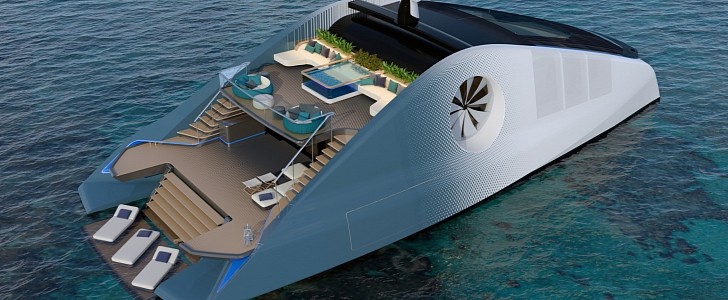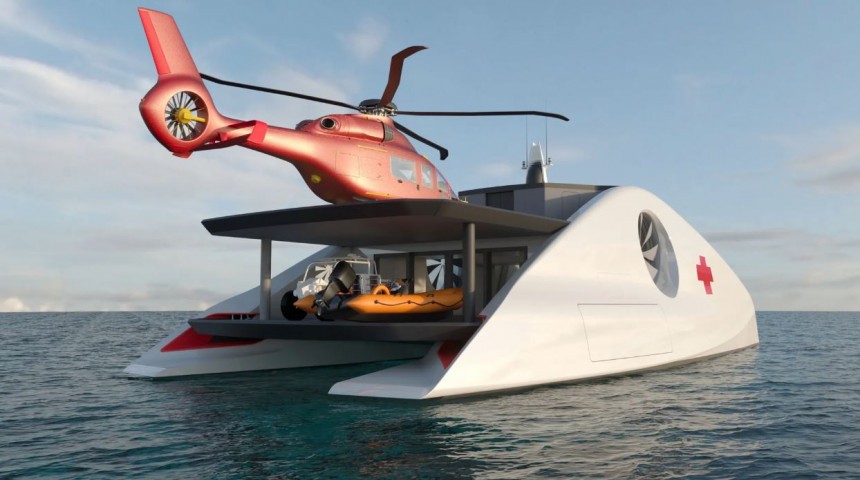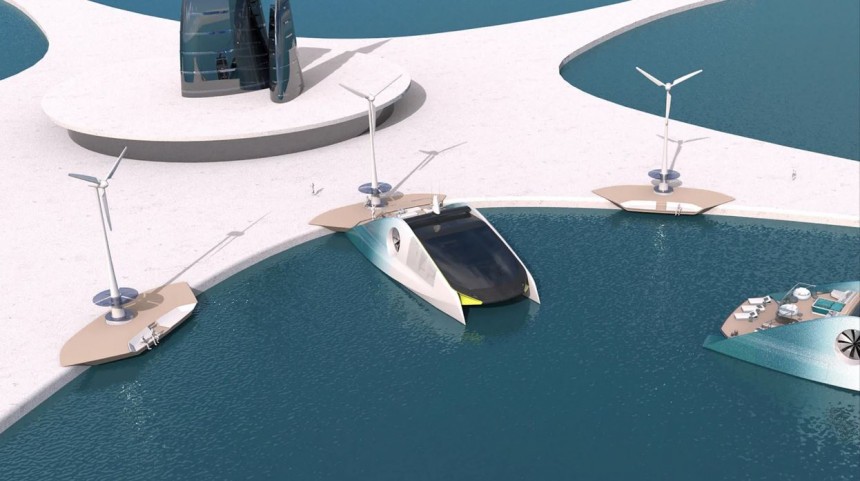The future is always just one step away from the accomplishments of the past. And we can always learn from the past to improve the future.
When we think of what the future might bring in terms of automotive or naval design, we could be misled into imagining something that has never been done or imagined before. But the team at Luca Dini Design & Architecture knows that a solid future is rooted in the mistakes and the accumulated knowledge of the past.
July is autoevolution’s Italian Month. Luca Dini Design & Architecture, a design firm based in Firenze, Italy, focused on the area at the intersection of architecture and design (as its name clearly states), has been delivering the finest Italian style since 1996. The Cetacean multi-hull concept is a good example in this sense.
Cetacean is deeply anchored into the past but looking to a future that is fully sustainable and carbon neutral. You’re probably sick of reading these phrases time and time again, but as scientists warn, things aren’t about to get any better for our planet unless we take concrete action in this sense. Cetacean is a step in this direction, exploring what could be done in terms of naval design without compromise to form, function, or comfort.
Cetacean is a multi-hull, a 28-meter (91-foot) catamaran that stands out for its unique design and even more unique footprint. It has no carbon footprint to speak of, with the designers explaining that they came up with the inspiration for it after a collaboration in a protected marine area in the Middle East. This resulted in the desire to create a vessel that would allow exploration of such areas with minimal impact to them, if at all.
Cetacean is a carbon-neutral cat with multiple functionality. It can be outfitted with different configurations, depending on its intended use. For instance, it could be used as a shuttle from a marina to smaller areas, so it would be fitted with passenger seats and maybe a lounge area. It could serve as a mobile hospital, and would offer enough space for all the necessary equipment. It could be a cargo carrier, serving a mothership for supply runs, or could even double as a shadow vessel, carrying the toys and even a helicopter.
Last but not least, it could be used as a private vessel, a cat that would silently and sustainably sail across smaller distances, carrying 25 guests and 5 crew. It could be a gorgeous day boat or, with additional infrastructure built, a longer-range yacht. Luca Dini Design & Architecture chose to focus on this possible use for the cat in the renders released publicly earlier this month, when the project was unveiled.
As noted above, Cetacean looks to the past for inspiration, particularly the Badalone boat, designed in 1421 by Filippo Brunelleschi and built to carry marble blocks from Carrara to Florence for the Cathedral of Santa Maria del Fiore. The secondary source of inspiration is Leonardo da Vinci’s 1470 sketch for a boat that would use wind turbines for propulsion.
This concept uses solar panels to run all additional systems while in motion, and rechargeable batteries for the motors for propulsion. When docked at a specially-designed patented dock, the catamaran becomes “plug-in,” recharging fully in about four hours. “The dock, in fact, in correspondence with the parking position of the Cetacean, has been designed to both accommodate the ship and to recharge it through a patented system by absorbing the water’s tides and waves,” the design studio explains. If pressed for time, the dock guarantees “touch & go” recharging of just one hour.
With an aluminum structure, Cetacean would be light and efficient, as well as fast. The design studio estimates a top speed of 16 knots and a cruising speed of 12 knots, but mentions no range or final cost. This catamaran is a dream, but it’s also a proposition for a cleaner future – one that doesn’t sacrifice luxury, aesthetics or comfort for the sake of sustainability. Or, as the design studio puts it, “clean and harmonious lines come together in a vessel whose essence and philosophy is that of total respect for the environment.”
July is autoevolution’s Italian Month. Luca Dini Design & Architecture, a design firm based in Firenze, Italy, focused on the area at the intersection of architecture and design (as its name clearly states), has been delivering the finest Italian style since 1996. The Cetacean multi-hull concept is a good example in this sense.
Cetacean is deeply anchored into the past but looking to a future that is fully sustainable and carbon neutral. You’re probably sick of reading these phrases time and time again, but as scientists warn, things aren’t about to get any better for our planet unless we take concrete action in this sense. Cetacean is a step in this direction, exploring what could be done in terms of naval design without compromise to form, function, or comfort.
Cetacean is a carbon-neutral cat with multiple functionality. It can be outfitted with different configurations, depending on its intended use. For instance, it could be used as a shuttle from a marina to smaller areas, so it would be fitted with passenger seats and maybe a lounge area. It could serve as a mobile hospital, and would offer enough space for all the necessary equipment. It could be a cargo carrier, serving a mothership for supply runs, or could even double as a shadow vessel, carrying the toys and even a helicopter.
Last but not least, it could be used as a private vessel, a cat that would silently and sustainably sail across smaller distances, carrying 25 guests and 5 crew. It could be a gorgeous day boat or, with additional infrastructure built, a longer-range yacht. Luca Dini Design & Architecture chose to focus on this possible use for the cat in the renders released publicly earlier this month, when the project was unveiled.
As noted above, Cetacean looks to the past for inspiration, particularly the Badalone boat, designed in 1421 by Filippo Brunelleschi and built to carry marble blocks from Carrara to Florence for the Cathedral of Santa Maria del Fiore. The secondary source of inspiration is Leonardo da Vinci’s 1470 sketch for a boat that would use wind turbines for propulsion.
With an aluminum structure, Cetacean would be light and efficient, as well as fast. The design studio estimates a top speed of 16 knots and a cruising speed of 12 knots, but mentions no range or final cost. This catamaran is a dream, but it’s also a proposition for a cleaner future – one that doesn’t sacrifice luxury, aesthetics or comfort for the sake of sustainability. Or, as the design studio puts it, “clean and harmonious lines come together in a vessel whose essence and philosophy is that of total respect for the environment.”








